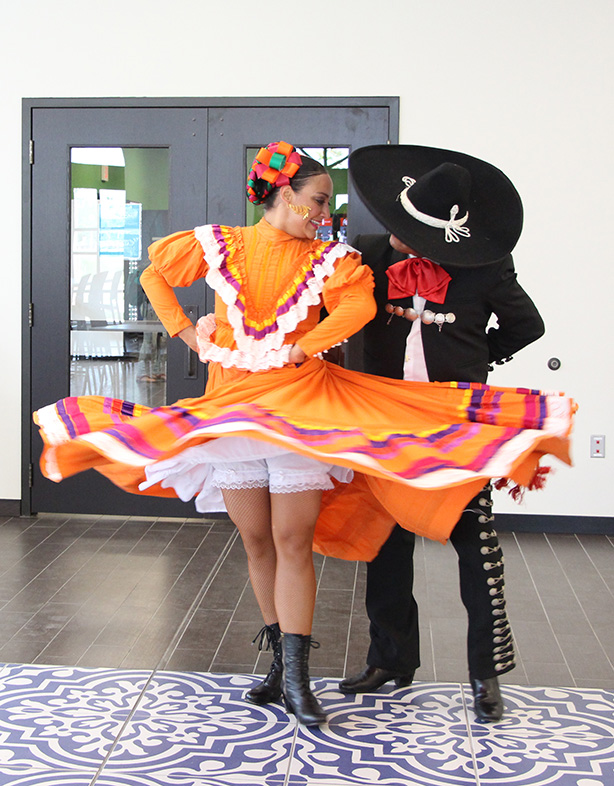
By Rebecca Salinas
The steady waving of colorful, lace-adorned Folklorico dresses and the traditional grito — the lyrical, trilling Mexican shout of joy — brightened the cafeteria Sept. 15 as the Guadalupe Dance Company kicked off this university’s Hispanic Heritage Month festivities.
While captivated students and employees attempted to follow the perfected footwork with their eyes, dancers beamed with energy with their rosy cheeks and decorated props.
The office of student activities hosted the performance, and will host two other events in honor of Hispanic Heritage Month, paid for through student services fees.
Mexican pastries and coffee will be served from 8:30-10 a.m. in the Central Academic Building’s Game Room at Main Campus and 4-6 p.m. in the Welcome Center at Brooks City-Base Campus. Also, a showing of the documentary, “Compañeras,” America’s first all female mariachi group, will play at noon and 3 p.m. in CAB Suite 219 at Main Campus.
Last week, the bold folklorico dancers, who have been called on to perform at many places to honor Hispanic Heritage Month, were taking a break from practicing for this weekend’s Rio Bravo production.
This year marks the 20th anniversary of the play that features the evolution of music and dance along the U.S.-Mexico border. In preparation for the event, Associate Dance Director Belinda Menchaca and Artistic Director Jeannette Chavez say dancers practice around three to four hours daily.
Reflecting for a moment after the university’s event, Chavez says the play, as well as folklorico dancing in general, nods to Texans of various cultures.
“It’s a part of San Antonio and Texas history,” she said. “That goes for all of us, whether or not we’re Hispanic descent or Mexican descent.”
Menchaca said when her family visits from Mexico, they feel impressed with how the culture has passed from generation to generation.
“It gives us an identity, but it also gives us a great sense of pride and a great sense of joy to be able to share our culture through music and dance,” she said. “Folklorico dancing is actually very, very popular throughout the entire country.”
Chavez added that she fell in love with folklorico dancing when she was three years old, even though it was something new to her family.
Her parents did not instill folklorico dancing or Hispanic heritage into the lives of her older siblings, but when she started dancing, it “was this whole reconnecting with roots,” she said.
Now, her niece dances folklorico, and she says it is an “awesome full circle.”
The dance company offers folklorico lessons for all ages, but the youngest age group is the largest, Menchaca explained.
“We all are dance teachers, so it is very important for us to keep that culture alive among our students as well. It’s a connection to their parents, a connection to their grandparents,” Menchaca said.
Styles of folklorico
Dancers performed four different styles of folklorico dancing: Veracruz, Campeche, Sinaloa and Jalisco.
Each of Mexico’s 31 states has its own style of dance, Menchaca said, varying in technique and costume.
“People of that region began dances, the costuming, the music and the instrumentation, so a lot of it has to do with where it’s located geographically,” she said.
For example, the first dance, Veracruz, displayed a “tropical” feel because of its location along the Gulf of Mexico.
Dancers wore light, white dresses adorned with flowers and lace, representing the foam of the ocean, Menchaca said.
The flowers and lace, as well as the fans they used as props, are influences from Europeans, which heavily used Veracruz’s ports during the 16th-19th centuries.
Menchaca added that for the Campeche-styled dance, performers balanced a tray containing cups and a bottle on their head because it symbolizes competition.
When dancers balance a candle on their head, she said it symbolizes “light the way,” although she is unsure of the exact origin.
“Somebody started that one night, and it just became tradition,” she said. “To really find out where that tradition started would be great.”
She said folklorico dancing first began with large gatherings, then it eventually became popular enough for formal performances.
At the gatherings, families and friends would attend in everyday clothing, but now folklorico is stylized with flamboyant costumes.
“We’ve been to festivals in Veracruz, where the entire stage is packed. It’s a festival, people are drinking, eating and it’s not a performance per se, it’s just that musicians are playing and dancers just want to dance,” she said.
Rio Bravo
After the performance in the cafeteria, dancers scurried to gather their costumes and props to carry on with the rest of their day. In the evening, they reconvened to practice for the upcoming Rio Bravo production.
“I live it and breathe it 24-7,” Chavez said, anticipating the play that will take place at 8 p.m. on Friday and Saturday and 3 p.m. on Sunday at the Guadalupe Theater.
This year marks the 20th anniversary of the production, which Guadalupe Cultural Arts Center showed in July 1994.
Chavez said this event is memorable for her because she is able to work with maestro Rafael Zamarripa, the original choreographer of Rio Bravo.
“It’s really amazing and life changing,” she said, because she respects Zamarripa’s success with incorporating folklorico with theatrics. “He took folklorico dance to a whole new level.”






